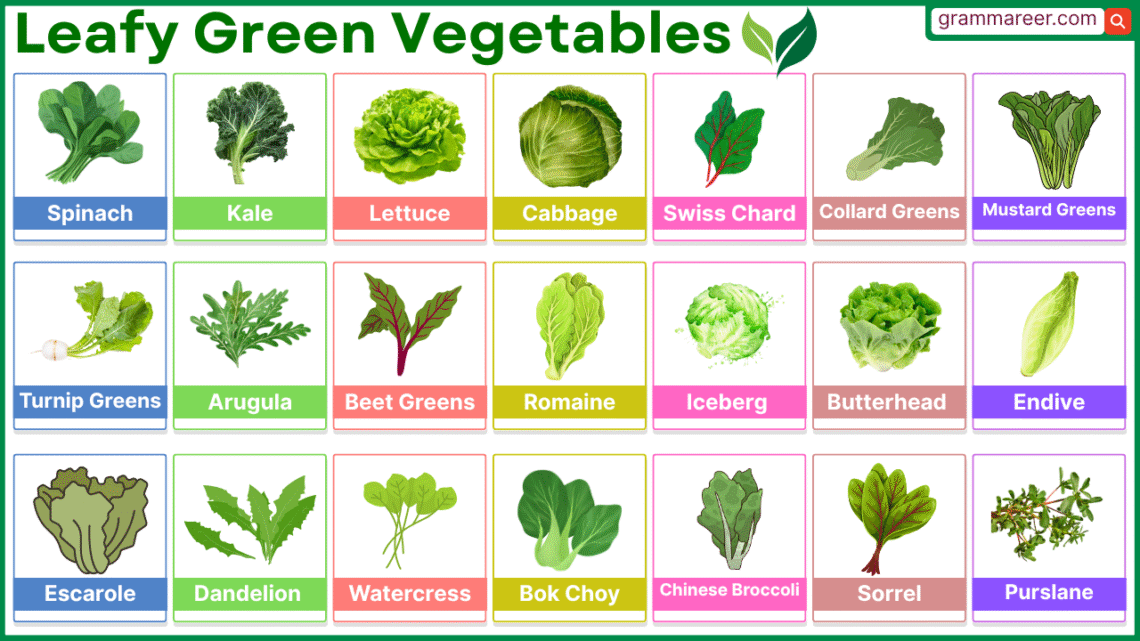Learning leafy vegetables names helps readers identify edible greens used in global recipes. This post groups these vegetables by type, use, and region to build solid cooking vocabulary. Each name is clearly categorized to improve food-related understanding in English. Perfect for ESL learners or anyone expanding their vegetable vocabulary, it includes many common and regional varieties. It’s also designed for better SEO and visual intent with pictures included.
Table of Contents
Leafy Vegetables Names and their Pictures
Learning leafy vegetables names helps you understand how different greens are used in food and cooking. Below is a list of leafy vegetables often found in English vocabulary and cooking vocabulary.
Bok Choy: Bok choy is a mild green vegetable rich in vitamins and often used in stir-fried dishes.
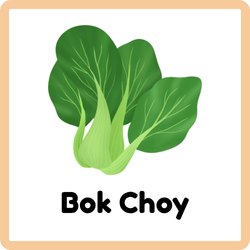
Dandelion Greens: These bitter leaves are full of nutrients and can be eaten in salads or lightly cooked.

Escarole: Escarole is a leafy green with slightly bitter flavor that adds depth to soups and stews.
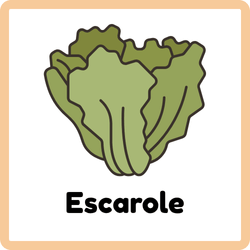
Swiss Chard: Swiss chard has colorful stems and large leaves, making it perfect for sautéing or steaming.

Fenugreek Leaves: Fenugreek leaves have a unique aroma and are often used in curries to boost flavor.

Romaine: Romaine lettuce is crisp and refreshing, commonly used in salads or as a sandwich topping.
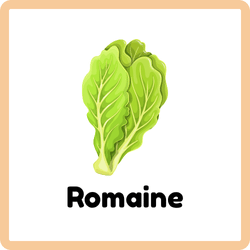
Collard Greens: Collard greens are hearty and nutritious, often slow-cooked to soften their slightly bitter leaves.

Butterhead Lettuce: Butterhead lettuce has soft, tender leaves with a sweet taste, ideal for fresh salads.

Kale: Kale is a superfood green with curly leaves, full of vitamins and minerals for healthy meals.
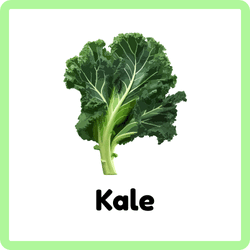
Mustard Greens: Mustard greens have a peppery flavor and are rich in antioxidants, often used in stir-fries.

Chinese Broccoli: Chinese broccoli has thick stems and leafy tops, perfect for steaming or adding to noodle dishes.

Arugula: Arugula is a peppery leafy green, great for salads, sandwiches, or as a pizza topping.
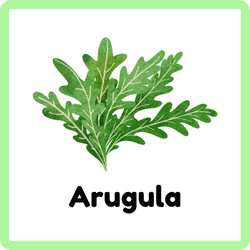
Iceberg Lettuce: Iceberg lettuce is crisp and mild, often used in salads and burgers for added crunch.

Endive: Endive has slightly bitter leaves, perfect for salads or as a base for appetizers with dips.

Watercress: Watercress has tiny green leaves and a peppery taste, often added to soups and sandwiches.

Turnip Greens: Turnip greens are nutrient-rich and slightly bitter, commonly cooked or added to soups for flavor.

Beet Greens: Beet greens are leafy tops of beets, edible and full of nutrients, sautéed or added to soups.

Lettuce: Lettuce is a versatile leafy green, mild in flavor, and commonly used in salads and wraps.

Cabbage: Cabbage has crunchy leaves and can be eaten raw, fermented, or cooked in a variety of dishes.
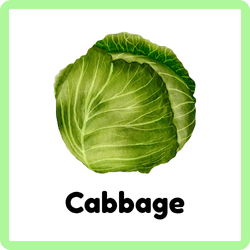
Spinach: Spinach is soft and tender, packed with iron, perfect for salads, soups, and smoothies.
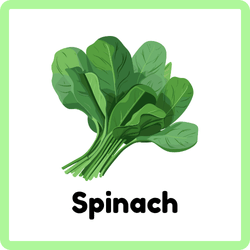
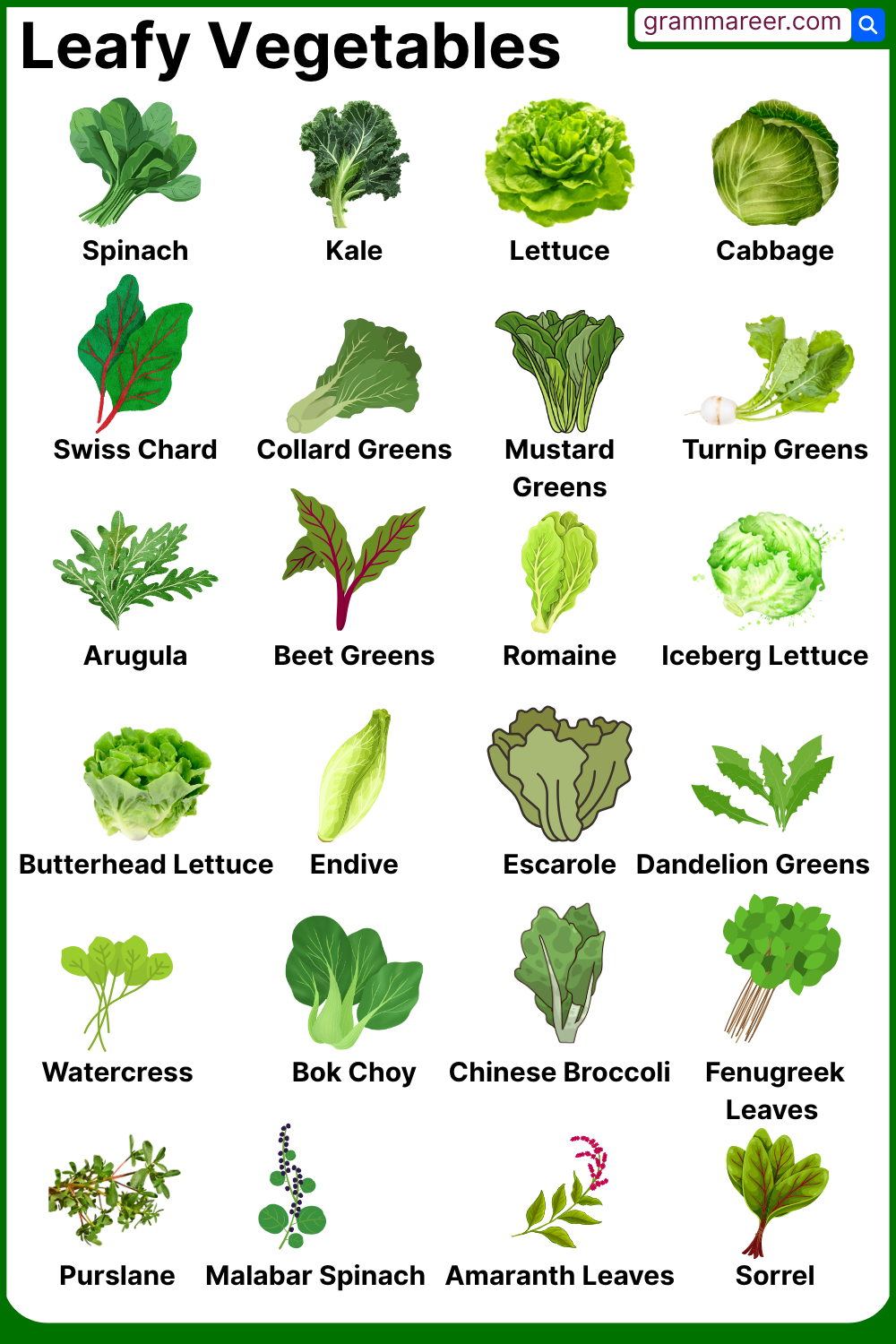
Types of Leafy Vegetables Names and their List
Leafy vegetables are classified based on their origin, flavor, and usage. Below is a categorized list that groups them for easier learning.
Common Leafy Greens
These are widely available and used in regular cooking.
- Spinach
- Lettuce
- Kale
- Cabbage
- Romaine
- Iceberg Lettuce
- Swiss Chard
- Collard Greens
- Mustard Greens
- Arugula
Leafy Herbs Used as Vegetables
Some herbs are leafy enough to be used like vegetables in large quantities.
- Parsley
- Cilantro
- Mint
- Basil
- Dill
- Fenugreek Leaves (Methi)
- Curry Leaves
- Sorrel
- Chervil
- Sage
Edible Leaves from Trees and Shrubs
These leaves are not herbs but are still edible and used in specific dishes.
- Moringa Leaves
- Mulberry Leaves
- Grape Leaves
- Neem Leaves
- Bay Leaves
- Cassava Leaves
- Olive Leaves
Wild Leafy Vegetables
These grow naturally in the wild and are often foraged.
- Dandelion Greens
- Lamb’s Quarters
- Purslane
- Wild Spinach
- Amaranth Leaves
- Stinging Nettle
- Chickweed
- Sorrel
Asian Leafy Greens
These vegetables are widely used across East and Southeast Asian cuisines.
- Bok Choy
- Napa Cabbage
- Chinese Broccoli (Gai Lan)
- Taro Leaves
- Water Spinach (Kang Kong)
- Chrysanthemum Greens
- Tatsoi
- Mizuna
- Malabar Spinach
- Edible Ferns
Mediterranean Leafy Vegetables
Common in Southern European cooking, especially salads and stews.
- Dandelion Greens
- Chicory
- Escarole
- Endive
- Sorrel
- Arugula
- Swiss Chard
- Spinach
Leafy Vegetables Commonly Used in Cooking
Leafy vegetables play different roles in cooking, depending on their flavor and texture. Below are grouped lists based on culinary usage.
For Salads
These are tender and often eaten raw.
- Lettuce
- Arugula
- Romaine
- Spinach
- Watercress
- Endive
- Baby Kale
- Red Leaf Lettuce
For Stir-Fry
Used in quick-cooked dishes with oil and spices.
- Bok Choy
- Kale
- Swiss Chard
- Napa Cabbage
- Chinese Broccoli
- Water Spinach
- Collard Greens
- Tatsoi
For Soups and Stews
These hold up well when boiled or simmered.
- Spinach
- Moringa Leaves
- Kale
- Mustard Greens
- Turnip Greens
- Swiss Chard
- Amaranth Leaves
- Malabar Spinach
Leafy Vegetables Grown at Home
Many leafy greens are easy to grow in home gardens or pots.
- Spinach
- Lettuce
- Kale
- Mint
- Cilantro
- Basil
- Arugula
- Mustard Greens
- Swiss Chard
- Fenugreek
Regional Leafy Vegetables Names around the World
Leafy vegetables vary by region based on local cuisine and agriculture. Below are grouped examples.
South Asian Leafy Vegetables
Used in Indian, Pakistani, and Bangladeshi cooking.
- Methi (Fenugreek Leaves)
- Palak (Spinach)
- Bathua (Chenopodium)
- Sarson (Mustard Greens)
- Amaranth Leaves
- Curry Leaves
- Malabar Spinach
- Colocasia Leaves
African Leafy Greens
Traditional vegetables rich in nutrients and used in stews.
- Cassava Leaves
- Spider Plant Leaves
- Cowpea Leaves
- Sweet Potato Leaves
- Amaranth Leaves
- Jute Leaves
- African Nightshade
- Pumpkin Leaves
East Asian Leafy Vegetables
Common in Chinese, Japanese, and Korean dishes.
- Bok Choy
- Napa Cabbage
- Chrysanthemum Leaves
- Tatsoi
- Mizuna
- Chinese Spinach
- Edible Ferns
Western Leafy Greens
Popular in North American and European meals.
- Lettuce
- Kale
- Arugula
- Swiss Chard
- Romaine
- Collard Greens
- Endive
- Spinach
List of Leafy Vegetables with Uses and Health Boosting Benefits
| Leafy Vegetable | Common Uses | Health Benefits |
|---|---|---|
| Spinach | Soups, curries, smoothies | Improves blood health, rich in iron and folate |
| Kale | Salads, chips, juices | Loaded with antioxidants and vitamin K |
| Lettuce | Sandwiches, salads | Keeps body hydrated, low in calories |
| Mustard Greens | Pickles, stir-fries | Supports digestion, detoxifies liver |
| Collard Greens | Steamed, sautéed | Boosts bone strength, full of calcium |
| Swiss Chard | Salads, wraps, stir-fry | Lowers blood sugar, rich in magnesium |
| Arugula | Pizzas, salads, sandwiches | Improves metabolism, high in vitamin C |
| Cabbage | Slaws, soups, rolls | Aids digestion, cancer-fighting compounds |
| Romaine Lettuce | Caesar salad, wraps | Protects vision, rich in vitamin A |
| Beet Greens | Sautéed, in omelets | Supports bone and kidney function |
| Watercress | Salads, soups, sandwiches | Cleans blood, anti-aging properties |
| Bok Choy | Stir-fry, soups, steamed | Strengthens bones, low in calories |
| Dandelion Greens | Herbal teas, soups | Detoxifies body, helps with inflammation |
| Turnip Greens | Boiled, sautéed | Supports immunity, improves heart function |
| Endive | Salads, appetizers | Promotes gut health, aids digestion |
| Radish Leaves | Curries, soups | Aids liver function, reduces fatigue |
| Fenugreek Leaves (Methi) | Indian dishes, paratha | Controls diabetes, boosts milk production |
| Coriander Leaves | Garnish, chutneys | Aids digestion, improves skin health |
| Mint Leaves | Drinks, desserts, chutneys | Freshens breath, relieves indigestion |
| Basil Leaves | Pastas, soups, herbal teas | Anti-inflammatory, relieves stress |
| Parsley | Garnish, salads, sauces | Purifies blood, rich in vitamin K |
| Curry Leaves | South Asian cooking | Supports hair growth, improves insulin function |
| Celery Leaves | Soups, salads, seasoning | Anti-inflammatory, rich in fiber |
| Sorrel Leaves | Soups, curries, chutneys | Boosts immunity, good source of vitamin C |
| Amaranth Leaves | Curries, dals | Enhances stamina, good for heart health |
| Malabar Spinach | South Indian dishes, curries | Aids digestion, rich in calcium |
| Chicory Leaves | Cooked as greens, salad addition | Detoxes liver, promotes digestion |
| Purslane | Salads, cooked dishes | Contains omega-3, improves brain function |
| Iceberg Lettuce | Burgers, sandwiches | Provides hydration, low-calorie option |
| Vietnamese Coriander | Southeast Asian cuisine | Improves digestion, antimicrobial |
| Taro Leaves | Cooked in curries with caution | High in fiber, supports blood pressure |
| Pumpkin Leaves | Stir-fried, in soups | Boosts vision, supports immunity |
| Sweet Potato Leaves | Soups, sautéed | Improves skin health, rich in antioxidants |
| Broccoli Leaves | Stir-fried, steamed | Fights cancer, improves bone health |
| Spring Onion Greens | Garnish, cooked dishes | Lowers blood sugar, improves heart health |
| Chinese Cabbage (Napa) | Stir-fry, kimchi | Rich in fiber, promotes brain function |
| Leek Greens | Soups, casseroles | Supports heart and vision |
| Horseradish Leaves | Used sparingly in salads | Natural antibiotic, supports digestion |
| Grape Leaves | Stuffed wraps (dolma) | Improves digestion, supports healthy bones |
| Fig Leaves | Cooked or used in tea | May lower blood sugar levels |
| Neem Leaves | Medicinal uses, bitter dishes | Fights infections, purifies blood |
| Drumstick Leaves (Moringa) | Soups, powder, herbal tea | Boosts energy, high in protein |
| Pea Shoots | Stir-fry, salads | Contains vitamins A, C, and folate |
| Lotus Leaves | Wraps in Asian cuisine | Improves fat digestion |
| Snake Gourd Leaves | Curries and herbal uses | Regulates blood sugar, detoxifies |
| Bottle Gourd Leaves | Curries, stir-fry | Cools the body, promotes digestion |
| Radicchio | Salads, grilled | Improves circulation, rich in antioxidants |
| Perilla Leaves | Wraps, Korean dishes | Rich in omega-3, anti-allergy properties |
FAQs
Some of the most commonly used leafy vegetables include spinach, lettuce, kale, cabbage, collard greens, and arugula. These are often used in salads, soups, stir-fries, and curries.
Spinach, moringa leaves, amaranth, and fenugreek leaves are considered healthy for daily meals. They’re rich in iron, fiber, and vitamins, and suit many cuisines.
Herbs like coriander, mint, and basil are often used for flavoring, while leafy vegetables like lettuce and cabbage are eaten in larger amounts as a main part of dishes.
Yes, many leafy vegetables such as lettuce, spinach, kale, and mustard greens are easy to grow at home in pots or small gardens with moderate sunlight and water.
Yes, edible tree leaves like moringa leaves, curry leaves, and neem leaves are used in many traditional recipes, especially in South Asian and African cuisines.
You May Also Like

